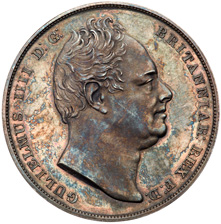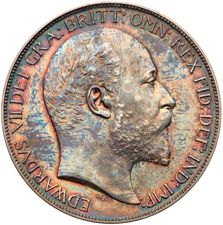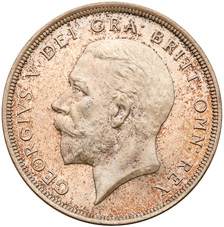
|
Sale 114
The New York Sale
| Great Britain The Neil Smith Collection |
| |
| |
| Lot |
Photo |
Description |
Bidding |
Lot 528 |
 |
William IV (1830-37), Silver Proof Crown of Five Shillings, 1831. Engraved by William Wyon, bare head right, W.W. incuse on truncation, legend and outer toothed border surrounding, GULIELMUS IIII D: G: BRITANNIAR: REX F: D:, toothed border around rim both sides, rev. quartered shield of arms with a crowned escutcheon of the Arms of Hanover, within Order of the Garter upon crowned robed mantle, date below, ANNO 1831, outer toothed border surrounding, edge plain, weight 26.88g (Bull 2462; L&S 1; ESC 271 R2; KM.715; S.3833). Attractively toned, some light imperfections in the toning, practically as struck, good extremely fine, and rare. Value $20,000 - UP
The magnificent silver Proof Crowns of King William IV are the largest portrait coins readily available of him. William Wyon produced them to go towards the complete proof sets dated for the year of his Coronation of which it is thought some 120+ sets were produced. The 1831 dated proof Crown exists in two varieties, the first that had Wyon's name spelt out in full in raised letters on the truncation, as Pistrucci had once done in the reign of George III. It seems this initial pattern was not accepted as the coin to go towards the proof set; as the die was altered to read merely W.W. incuse on the truncation as we have herewith, and for the bulk of the coins that exist today. Some very rare transitional pieces show a trace of the W.WYON with lines ruled over the top to erase it on the struck coins and the W.W. incuse to the left, but most show merely the W.W. incuse as we have demonstrated herewith.
The Latin legend translate as on the obverse "William the Fourth, by the grace of God, King of the Britons, Defender of the Faith" with the reverse as "In the year 1831.".
Purchased from Spink and Son Ltd. when at the New York International Coin Convention, 13th December 2000.
View details and enlarged photos
|
|
Lot 529 |
 |
Victoria (1837-1901), Silver Proof Crown of Five Shillings, 1839. Engraved by William Wyon, young filleted head left, W. WYON. RA raised on truncation, date below, legend and outer toothed border with raised rim surrounding, VICTORIA DEI GRATIA, rev. crowned quartered shield of arms within wreath, emblems below, legend and outer toothed border with raised rim surrounding, BRITANNIARUM REGINA FID: DEF:, edge plain, weight 28.27g (Bull 2560 R; Davies 430; ESC 279 R; L&S 38; KM.741; S.3882). Attractively toned, with a few blemishes, practically as struck, mint state and rare. Value $15,000 - UP
The 1839 Proof Crown was issued as the largest silver portrait coin, a component for the proof sets of the coinage dated 1839, which included the largest gold coin portrait with the Five Pounds with the Una and the lion reverse. All the coinage was the work of Chief Engraver William Wyon whose name at last appears prominently on the truncation of the young Queen with R.A. after to indicate his membership of the Royal Academy of Arts. The exact mintage of the proof sets of coins dated 1839, which contained this sort of Crown are not exactly known, and apparently it took a number of years to actually sell the stock of the proof sets, but is often quoted as circa 300 sets issued.
The Latin legends translates on obverse as "Victoria by the Grace of God," and on the reverse "Queen of the Britons, Defender of the Faith."
Ex Sotheby, coins and medals auction, 17th November 2000, lot 579.
View details and enlarged photos
|
|
Lot 530 |
 |
Edward VII (1901-10), Silver Matt Proof Crown of Five Shillings, 1902. Obverse design by George William De Saulles, bare head right, DES below truncation for engraver George William De Saulles, legend and outer toothed border surrounding, EDWARDVS VII DEI: GRA: BRITT: OMN: REX FID: DEF: IND: IMP:, rev. design by Benedetto Pistrucci, St George and dragon right, date in exergue, B.P. initials to upper right for designer Benedetto Pistrucci, outer toothed border surrounding, edge inscribed in raised letters, DECUS ET TUTAMEN * ANNO REGNI II *, weight 28.17g (Bull 3562; ESC 362; L&S 2; Davies 1530; KM.803; S.3979). Toned, practically as struck mint state. Value $250 - UP
This date 1902 is the only time a matt finish coinage has been produced thus far for a UK Coronation set of coins and was already a trend in vogue for medallions at that time. The engraver of these coins was George William De Saulles who sadly died aged 41 the year after these sets were issued, and who had a personal preference for the matt finish having first produced Queen Victoria's Diamond Jubilee Royal Mint medallions of 1897 with the same finish. The mint issued the proof sets as either "long sets" which included the gold Five Pounds and Two Pounds, or as "short sets" which was from the gold Sovereign down to the maundy penny. Both sets included the silver matt proof Crown of which the mintage totalled 15,123 pieces.
The Latin legend on the obverse translates as "Edward the Seventh, by the grace of God, King of all the Britons, Defender of the Faith, Emperor of India."
Purchased from Spink and Son Ltd, 20th November 2000.
View details and enlarged photos
|
|
Lot 531 |
 |
George V (1910-36), Silver Wreath Type Crown of Five Shillings, 1934. Struck in 0.500 silver, obverse design by Bertram Mackennal, bare head left, BM raised on truncation for engraver Bertram Mackennal, legend and outer toothed border surrounding, GEORGIVS V DEI GRA: BRITT: OMN: REX, rev. Imperial crown, date above, emblematic wreath surrounding of roses, shamrocks and thistles, small K.G. to right of lowest rose for designer Kruger Gray, denomination in words at bottom, legend surrounding and outer toothed border surrounding.FID.DEF.IND.IMP., weight 28.32g (Bull 3647; ESC 374 R2; Davies 1637; KM.836; S.4036). Attractively toned, with some mottling, uncirculated, very rare with only 932 examples struck. Value $5,000 - UP
The Wreath Crown design by Kruger Gray was much admired and the type design continued in succeeding years at the request of the Bank of England who liked to stock them at Christmas time for their clients, hence why the mintages were always quite small for the normal currency pieces. Bertram Mackennal (later knighted) was the Australian engraver responsible for the obverse design. The 1934 Crown was the smallest mintage of the wreath crown series, probably because the silver Jubilee designs of 1935 were already being anticipated as a fresh change from the wreath issue.
The legends translate across both sides of these denominations as "George the Fifth by the grace of God, King of all the Britons, Defender of the Faith, Emperor of India."
Ex Spink Coin Auction 1258, 5th October 2000, lot 690.
View details and enlarged photos
|
|
Lot 532 |
 |
Edward VIII (Jan-Dec 1936), Silver Pattern Crown of Five Shillings, 1937. Struck on 0.500 silver, bare head left, HP below for designer T. Humphrey Paget, legend and outer toothed border surrounding, EDWARDVS VIII D: G: BR: OMN: REX, rev. crowned quartered shield of arms, crowned lion supporter to left, unicorn supporter to right, K and G within legs of each supporter for reverse designer Kruger Gray, all on ground line with emblematic banner in three parts, DIEU /ET MON / DROIT, legend and outer toothed border surrounding, lower legend CROWN: 1937., upper legend FID: DEF: : IND: IMP, edge milled, weight 28.24g (Giordano P10a; Bull 4000 R6; Davies 2000; cf.L&S.p110; ESC -; KM.Pn131; S.4063). Toned, with some blemishes, very slight abrasion to small part at top of obverse rim, probably contemporary with manufacture, otherwise practically as struck, mint state and one of the key rarities to the Crown series, the only singular Crown currently available and an unrivalled opportunity for a collector, the only other Crown available is currently part of a complete set in the Tyrant Collection, of the highest rarity thus. Value $150,000 - UP
Of the highest rarity in the milled Crown series, this Edward VIII Proof Crown is currently the only single example available to purchase for a collector. The only other privately held example forms part of a complete set that seems unlikely to be separated, and has been recently displayed in Long Beach California. Edward VIII who controversially abdicated his throne for the woman he loved on 10th December 1936, was just about to authorise a new British coinage to be ready in time for his Coronation planned for 12th May 1937, and as a reuslt no British currency coin was issued for use by the general public.
This is only the fifth time this actual coin has ever been publicly auctioned, and the first time it has been seen for sale in the USA since its first auction outing in Houston, Texas in 1978.
The coinage had caused much controversy in development mainly from Edward's refusal to follow the coinage tradition to face the opposite direction to his predecessor, as his father King George V had faced left. This tradition dated back to King Charles II who had wished to face the opposite way to Oliver Cromwell on his English coinage, and was followed by all succeeding monarchs, until Edward VIII who preferred his left facing profile. In Edward�s memoirs there is an account of his own discussions with Sir Robert Johnson the Deputy Master (pp.293-294), between February and April 1936 revealing that the mint went as far as instructing Thomas Humphrey Paget the artist in favour, as he had impressed the King with his effigy upon the Master Mariner medal (Giordano CM139), to transfer the King's left side facial features to a right facing portrait (not including the hair in this transition) before Edward insisted, as was his privilege, for his left facing portrait only to feature on coins and stamps. Subsequently the Deputy Master had to report to the Chancellor of the Exchequer that the King insisted on facing left, which was approved.
One of the earliest announcements of a coinage dating from the 9 July 1936, by the then Chancellor of the Exchequer, Mr Neville Chamberlain stated that where "in accordance with custom" specimen sets, of the first issue of coins of King Edward VIII would be issued to collectors and others requiring them. Sets of gold coins would be available at special prices to all who applied. More significantly the report ends with news that "A Coronation set of gold coins consists of four pieces - £5, £2, £1 and a half-sovereign" (reported in the Daily Telegraph, 10 July 1936, repeated in the Spink Numismatic Circular August 1936, p.283), especially interesting as eventually no gold Half-Sovereign was ever produced.
Trial strikes of proposed coinage designs were shown to the King on 24th July 1936 for final approval, where he chose the bare head left facing effigy by T. H. Paget to represent him on the obverse of British coins, and a crowned bust by Percy Metcalfe for the Dominions. A series of heraldic designs were chosen for the reverses of the silver denominations designed by Kruger Gray with the classic St George and dragon design after Pistrucci for the gold coinage reverses. An unusual shaped new denomination of the brass dodecagonal Threepence featuring a thrift plant design by Madge Kitchener was also to be introduced for the first time. The bronze Penny reverse was engraved by C W Coombes, the bronze Halfpenny ship reverse design was adapted from a proposed Halfcrown by T. H. Paget, and the bronze Farthing reverse with the wren by H. Wilson Parker (Dyer pp.12-19).
The Royal Mint reports for 1935-1936 revealed that at the time of the abdication in December 1936, some 200 dies for coins, medals, and seals that had been prepared for use, had had to be scrapped. The whole process of coinage preparation as well as medals and seals, had to start all over again for King George VI, though the chosen artists for the obverse portraiture Mr Paget and Mr Metcalfe remained the same as for his elder brother.
In Portraits of Prince, Giordano has tried to trace all the sets and singles of the actual proof coins, and they are listed in a table on page 254. In relation to the silver Crown, Giordano gives a total of six examples of the brilliant proof in existence, two of which are held privately, one being this coin the other being a component part of a complete set; the other four Crowns being all institutionalized as integral parts of complete sets. The locations of the four sets in institutions are listed as Royal Family, British Museum and two in the Royal Mint. There is additionally a matt proof version of this Crown (Giordano P10b) which is in the Royal Mint Museum.
As an epilogue Giordano reveals that the Duke of Windsor tried to obtain a set of the British proof coins featuring his portrait from the Royal Mint, as can be seen from a Royal Mint memorandum of 3 December 1951 (Giordano letter C, p.258). The request was deferred for an answer from George VI himself, who refused his elder brother's request. The Duke of Windsor died 25 May 1972. An unrivalled opportunity occurs now to bid for and own a piece of history and we repeat, this is the only King Edward VIII silver Crown currently available that is not an integral component part of a proof set.
For further reading of how the proposed coinage progressed from start till the King's abdication please see "The Proposed Coinage of Edward VIII" by G P Dyer, published by HMSO 1973. Portraits of a Prince � Coins Medals and Banknotes of Edward VIII, by Joseph S Giordano Jr, published 2009. A King's Story, The Memoirs of HRH The Duke of Windsor KG, published 1951.
The Latin legends translate as on obverse "Edward the Eighth, by the grace of God, King of all the Britons," and on the reverse as "Defender of the Faith, Emperor of India" with the French language garter motto as "God and my right.".
Ex Richard Lobel Collection, Bowers and Ruddy, Los Angeles, A.N.A. Houston Auction, 21-26th August 1978, lot 2933. Ex Spink Coin Auction 124, 18-19th November 1997, lot Ex Sotheby, 29th June 1998, lot Ex Spink Coin Auction 1261, 15th November 2000, lot 346.
View details and enlarged photos
|
|
Lot 533 |
 |
George VI (1936-52), Proof Crown, 1951. Struck in cupro-nickel, Festival of Britain issue, bare head left, HP below for designer Humphrey Paget, denomination FIVE SHILLINGS below, legend and outer toothed border surrounding, GEORGIVS VI D: G: BR: OMN: REX F: D:, rev. St George and dragon right, date in exergue, B.P. to upper right of exergue for designer Benedetto Pistrucci, outer toothed border and raised rim surrounding, edge with incuse legend, *MDCCCLI CIVIUM INDUSTRIA FLORET CIVITAS MCMLI, weight 28.30g (Bull 4024; Davies 2020; ESC 393C; L&S 8; KM.880; S.4111). Toned proof as issued in the Festival of Britain set, mint state. Value $250 - UP
These Crowns were produced to commemorate the Festival of Britain which took place on the South Bank of the River Thames in London opening on the 4th May 1951 for five months which was literally 100 years after the Great Exhibition in London�s Hyde Park from May to October 1851. The Royal Mint exhibited on the 27-acre site where many individual currency crowns were struck on site to sell to the festival goers. Complete proof sets of the coinage of 1951 including this crown were also available for sale to the public of which some 20,000 sets were produced.
The Latin legends translate as on obverse "George the Sixth by the grace of God, King of all the Britons, Defender of the Faith" and additionally on the edge as "1851 by the industry of its people the State flourishes 1951.".
Purchased from Spink and Son Ltd, 20th November 2000.
View details and enlarged photos
|
|
Lot 534 |
 |
Elizabeth II (1952-), frosted VIP Proof Crown, 1960. Struck in cupro-nickel young laureate head right, M.G. incuse in truncation for designer Mary Gillick, denomination FIVE SHILLINGS below, legend and outer toothed border surrounding, ELIZABETH II DEI GRATIA REGINA F. D. rev. struck en medaille, crown at centre, cruciform emblems around, emblematic shields in angles, date either side of Welsh leek, tiny EF below Irish shield for co-designer Edgar Fuller, tiny CT below English shield for co-designer Cecil Thomas, outer toothed border and raised rim surrounding, edge milled, weight 28.26g (Bull 4338 R4; Davies 2290; ESC 393M; L&S 10; KM.909; S.4143). Attractively toned, with a lovely cameo contrast, practically as struck, mint state and rare. Value $650 - UP
These frosted design proofs were issued to "very important persons" in very small quantities as opposed to the currency pieces issued in the UK, and the special New York Exhibition pieces from polished currency dies which were sold at the Royal Mint stand in New York at that time. The world trade exhibition in New York was opened by Prince Philip the duke of Edinburgh of which a Pathe news film exists.
The Latin legends translate as on obverse "Elizabeth the Second, by the grace of God, Defender of the Faith."
Purchased from Spink and Son Ltd, 20th November 2000.
View details and enlarged photos
|
|
|
|